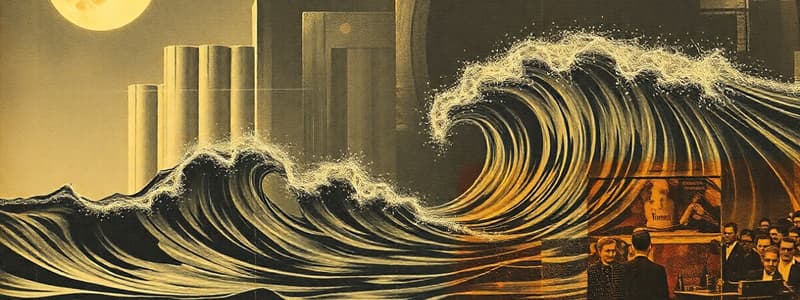Podcast
Questions and Answers
Which of the following experimental results provides evidence for the wave-particle duality of matter?
Which of the following experimental results provides evidence for the wave-particle duality of matter?
- The Compton effect, involving the scattering of photons by electrons.
- The photoelectric effect, where light behaves as particles.
- Blackbody radiation, explained by Planck's quantization hypothesis.
- The Davisson-Germer experiment, demonstrating electron diffraction. (correct)
The phase velocity of a wave packet is always equal to the group velocity.
The phase velocity of a wave packet is always equal to the group velocity.
False (B)
State Heisenberg's uncertainty principle mathematically, relating position and momentum.
State Heisenberg's uncertainty principle mathematically, relating position and momentum.
$\Delta x \Delta p \geq \frac{\hbar}{2}$
In quantum mechanics, operators that represent physical quantities have real eigenvalues, which correspond to the ______ values of those quantities.
In quantum mechanics, operators that represent physical quantities have real eigenvalues, which correspond to the ______ values of those quantities.
Match the following scenarios with the quantum mechanical phenomena they illustrate:
Match the following scenarios with the quantum mechanical phenomena they illustrate:
What is the physical significance of the square of the wave function, $|\Psi(x,t)|^2$?
What is the physical significance of the square of the wave function, $|\Psi(x,t)|^2$?
The zero-point energy is the minimum possible energy a quantum mechanical system can have and is always zero.
The zero-point energy is the minimum possible energy a quantum mechanical system can have and is always zero.
Briefly explain how the tunneling effect is utilized in a scanning tunneling microscope (STM).
Briefly explain how the tunneling effect is utilized in a scanning tunneling microscope (STM).
For a particle in an infinite potential well, the energy levels are ______, meaning that the particle can only have specific, discrete energy values.
For a particle in an infinite potential well, the energy levels are ______, meaning that the particle can only have specific, discrete energy values.
Which equation describes the time evolution of a quantum mechanical system?
Which equation describes the time evolution of a quantum mechanical system?
Flashcards
Wave-particle duality
Wave-particle duality
The concept that all matter exhibits both wave-like and particle-like properties.
de Broglie waves
de Broglie waves
Waves associated with a moving particle, defining its momentum and energy.
Davisson-Germer experiment
Davisson-Germer experiment
Experiment confirming the wave nature of electrons through diffraction patterns.
Electron diffraction
Electron diffraction
Signup and view all the flashcards
Wave function
Wave function
Signup and view all the flashcards
Wave packet
Wave packet
Signup and view all the flashcards
Group velocity
Group velocity
Signup and view all the flashcards
Phase velocity
Phase velocity
Signup and view all the flashcards
Uncertainty principle
Uncertainty principle
Signup and view all the flashcards
Schrödinger equation (1D)
Schrödinger equation (1D)
Signup and view all the flashcards
Study Notes
- Quantum mechanics studies the behavior of matter and energy at the atomic and subatomic levels.
- Wave-particle duality describes how every particle or quantum entity may be described as both a particle and a wave.
de Broglie Waves
- de Broglie waves postulate that all matter exhibits wave-like properties.
- The de Broglie wavelength (λ) is inversely proportional to its momentum (p): λ = h/p, where h is Planck's constant.
Davisson-Germer Experiment
- The Davisson-Germer experiment confirmed the wave nature of electrons.
- Electrons diffracted from a nickel crystal surface, creating an interference pattern.
Electron Diffraction
- Electron diffraction is the scattering of electrons by a periodic structure.
- This is used to determine the structure of crystals and molecules.
Wave Function
- The wave function (Ψ) is a mathematical description of the quantum state of a particle
- |Ψ|^2 gives the probability density of finding the particle at a given point in space.
- Wave functions must be finite, single-valued, and continuous.
Wave Packets
- A wave packet is a superposition of waves with different wavelengths.
- It represents a localized particle.
- Group velocity is the velocity of the wave packet as a whole
- Phase velocity is the velocity of the individual waves that make up the wave packet.
Uncertainty Principle
- The uncertainty principle states that it is impossible to know both the position and momentum of a particle with perfect accuracy.
- ΔxΔp ≥ ħ/2, where Δx is the uncertainty in position, Δp is the uncertainty in momentum, and ħ is the reduced Planck constant.
Schrödinger Wave Equation (1D)
- The Schrödinger equation describes the time evolution of a quantum mechanical system.
- The time-independent Schrödinger equation in 1D: -ħ²/2m d²Ψ(x)/dx² + V(x)Ψ(x) = EΨ(x), where m is mass, V(x) is the potential energy, and E is the total energy.
Eigenvalues and Eigenfunctions
- Eigenvalues are the allowed energy levels of a quantum system
- Eigenfunctions are the corresponding wave functions.
- Expectation values are the average values of physical quantities.
Free Particle
- A free particle has no potential energy (V(x) = 0).
- The solutions to the Schrödinger equation are plane waves.
Infinite Potential Well
- An infinite potential well confines a particle to a region of space.
- The potential energy is infinite outside the well and zero inside.
- Energy levels are quantized: En = (n²h²)/(8mL²), where n is an integer and L is the width of the well.
Finite Potential Well
- A finite potential well has a finite potential energy barrier at the edges.
- Particles can exist outside the well with reduced probability.
- Energy levels are quantized, but the energies are lower than those of an infinite well.
Tunneling Effect
- The tunneling effect is the ability of a particle to pass through a potential energy barrier even if its energy is less than the barrier height.
- The probability of tunneling decreases exponentially with the width and height of the barrier.
Scanning Tunneling Microscope (STM)
- An STM uses the tunneling effect to image surfaces at the atomic level.
Quantum Harmonic Oscillator
- A quantum harmonic oscillator is a system with a potential energy proportional to the square of the displacement.
- Energy levels are quantized: En = (n + 1/2)ħω, where ω is the angular frequency of the oscillator.
Zero-Point Energy
- Zero-point energy is the lowest possible energy that a quantum mechanical system may possess.
- For a quantum harmonic oscillator, the zero-point energy is E0 = (1/2)ħω.
Studying That Suits You
Use AI to generate personalized quizzes and flashcards to suit your learning preferences.




